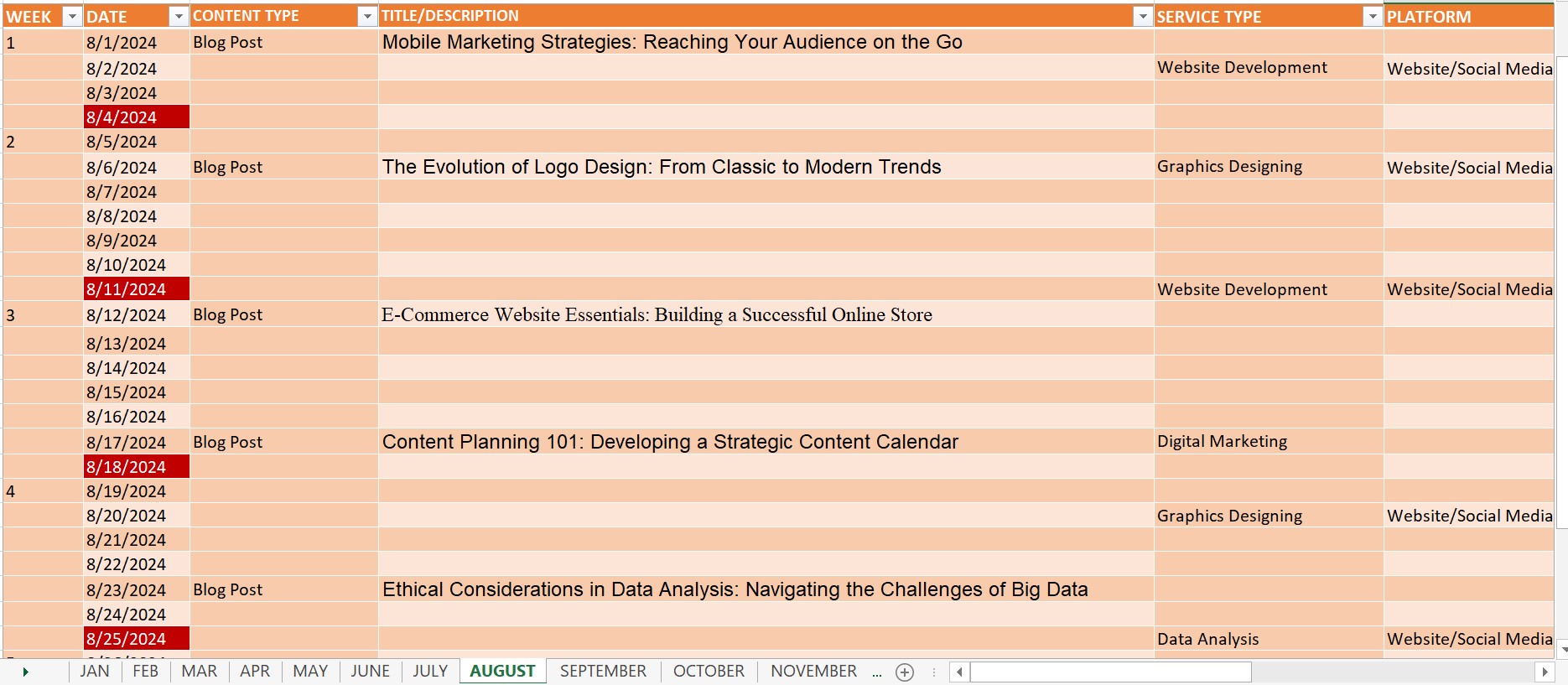A content calendar is a strategic tool used by businesses, marketers, and content creators to plan, organize, and schedule content across various platforms. Content is the cornerstone of digital marketing. It’s what attracts, engages, and retains your audience. However, creating high-quality content consistently requires a well-structured plan. This is where a content calendar becomes indispensable. A strategic content calendar is a roadmap that guides your content creation process, ensuring alignment with your business goals, target audience, and key marketing initiatives. This guide will take you through the steps of developing a strategic content calendar that drives results.
1. Understanding the Importance of a Content Calendar
Table of Contents
A content calendar is not just a tool to organize your content; it’s a strategic document that aligns your content with your business goals. It typically outlines what content will be published, when, and where, ensuring consistency and alignment with broader marketing goals. A content calendar helps streamline content production, improve time management, and ensure timely, relevant posts. Here’s why it’s crucial:
- Consistency: Regular posting is key to maintaining engagement with your audience. A content calendar helps you plan and ensure that content is consistently delivered.
- Efficiency: By planning content in advance, you can allocate resources more effectively, avoid last-minute scrambles, and reduce the stress of content creation.
- Alignment: A content calendar ensures that all content supports your broader marketing and business goals, providing a clear path from idea to execution.
- Analysis and Adjustment: Having a calendar allows you to track the performance of your content over time, making it easier to identify what’s working and adjust your strategy accordingly.
2. Setting Clear Objectives
Before diving into content creation, it’s essential to establish clear objectives. What do you want your content to achieve? Common objectives include:
- Brand Awareness: Increasing visibility and recognition of your brand.
- Lead Generation: Attracting potential customers and encouraging them to engage with your business.
- Customer Retention: Keeping existing customers engaged and satisfied.
- Thought Leadership: Establishing your brand as an authority in your industry.
Each piece of content should serve a purpose that aligns with these objectives. When you know what you’re aiming for, it’s easier to plan content that delivers results.
3. Identifying Your Audience
Understanding your target audience is fundamental to content planning. Who are you creating content for? What are their needs, preferences, and pain points? Consider the following when identifying your audience:
- Demographics: Age, gender, location, education level, etc.
- Psychographics: Interests, values, attitudes, lifestyle, etc.
- Behavioral Data: Purchase history, brand loyalty, interaction with content, etc.
Creating detailed audience personas can help you tailor your content to meet the specific needs of different segments of your audience. The more you understand your audience, the more effective your content will be.
4. Conducting a Content Audit
Before planning new content, it’s beneficial to conduct a content audit. A content audit involves analyzing your existing content to determine what’s working and what’s not. This process helps you identify content gaps, repurpose high-performing content, and ensure that your content strategy aligns with your current goals.
Steps to conduct a content audit:
- Inventory Your Content: Create a list of all the content you’ve produced, including blog posts, videos, social media updates, etc.
- Analyze Performance: Review metrics like page views, engagement, shares, and conversion rates to determine the effectiveness of each piece.
- Identify Gaps: Look for topics or formats that haven’t been covered but are relevant to your audience.
- Repurpose Content: Identify content that can be updated, repurposed, or expanded to maintain relevance.
5. Brainstorming Content Ideas
Once you’ve set objectives, identified your audience, and audited existing content, it’s time to brainstorm new content ideas. Effective brainstorming involves:
- Keyword Research: Identify popular search terms related to your industry to guide content topics.
- Competitor Analysis: Look at what your competitors are doing. What content are they producing, and how can you do it better?
- Audience Feedback: Pay attention to the questions and feedback from your audience. This can provide valuable insights into what content they want to see.
- Industry Trends: Stay informed about trends in your industry. Creating content around emerging topics can position your brand as a thought leader.
After brainstorming, categorize your ideas into themes or pillars that align with your content strategy. This ensures a balanced mix of content types and topics.
6. Creating the Content Calendar
With a wealth of ideas in hand, the next step is to create your content calendar. Here’s how to structure it:
- Choose a Calendar Format: Whether it’s a simple spreadsheet, a dedicated project management tool like Asana or Trello, or a specialized content calendar software like CoSchedule, choose a format that works best for your team.
- Set a Publishing Schedule: Decide on the frequency of your content. How often will you publish blog posts, social media updates, videos, etc.? Consistency is key, so choose a schedule that’s realistic and sustainable.
- Assign Responsibilities: Clearly define who is responsible for each piece of content, from creation to publication. This ensures accountability and smooth workflow.
- Include Key Dates: Incorporate important dates such as product launches, holidays, industry events, and marketing campaigns into your calendar. These dates should guide your content themes and timing.
- Plan for Different Content Types: Diversify your content by including various formats such as blog posts, videos, infographics, podcasts, and social media updates. Each type of content should cater to different segments of your audience and serve different objectives.
7. Developing Content Workflows
A strategic content calendar isn’t just about planning what to publish and when; it’s also about how the content will be created, reviewed, and published. Develop clear workflows for your content production process. Consider the following:
- Content Creation: Who will write, design, or produce the content? What resources are needed?
- Editing and Review: Who will review the content for accuracy, quality, and alignment with brand guidelines?
- Approval Process: Who needs to approve the content before it goes live?
- Distribution and Promotion: How will the content be distributed and promoted across various channels?
Having a well-defined workflow ensures that your content production is smooth and that quality is maintained at every stage.
8. Measuring and Adjusting
Your content calendar is a living document. To ensure its effectiveness, you must regularly review and adjust your strategy based on performance metrics. Key performance indicators (KPIs) to track include:
- Engagement: Likes, shares, comments, and overall interaction with your content.
- Traffic: Website visits generated by your content.
- Conversion Rate: The percentage of visitors who take a desired action, such as signing up for a newsletter or making a purchase.
- SEO Performance: Search engine rankings for keywords associated with your content.
Regularly reviewing these metrics allows you to identify what’s working and what isn’t, so you can make informed adjustments to your content strategy.
9. Staying Flexible
While planning is crucial, flexibility is equally important. The digital landscape is constantly evolving, and your content calendar should be able to adapt to changes. Whether it’s a sudden industry trend, an unexpected event, or a shift in your business goals, being able to pivot your content strategy is key to staying relevant.
Conclusion
A strategic content calendar is more than just a schedule—it’s a comprehensive plan that aligns your content efforts with your overall business objectives. By understanding your audience, setting clear goals, conducting a content audit, brainstorming ideas, and creating a detailed calendar, you can ensure that your content drives engagement, supports your marketing strategy, and contributes to your business’s success. Remember to stay flexible, measure your results, and adjust your strategy as needed to keep your content fresh and effective.




